brakes Lancia Delta 2010 Owner handbook (in English)
[x] Cancel search | Manufacturer: LANCIA, Model Year: 2010, Model line: Delta, Model: Lancia Delta 2010Pages: 276, PDF Size: 5.31 MB
Page 111 of 276
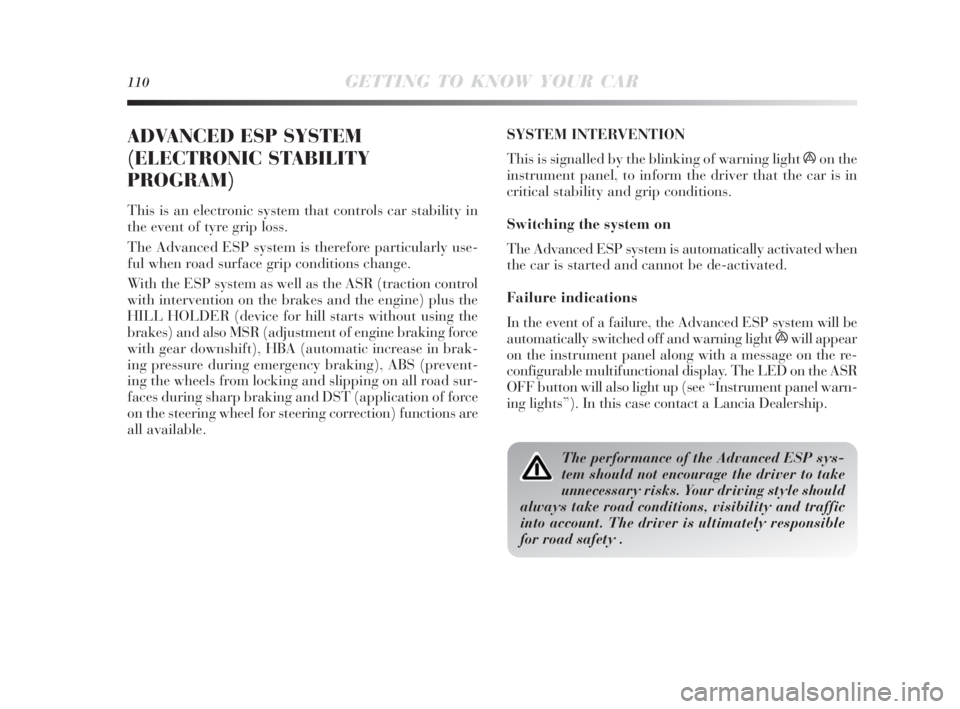
110GETTING TO KNOW YOUR CAR
ADVANCED ESP SYSTEM
(ELECTRONIC STABILITY
PROGRAM)
This is an electronic system that controls car stability in
the event of tyre grip loss.
The Advanced ESP system is therefore particularly use-
ful when road surface grip conditions change.
With the ESP system as well as the ASR (traction control
with intervention on the brakes and the engine) plus the
HILL HOLDER (device for hill starts without using the
brakes) and also MSR (adjustment of engine braking force
with gear downshift), HBA (automatic increase in brak-
ing pressure during emergency braking), ABS (prevent-
ing the wheels from locking and slipping on all road sur-
faces during sharp braking and DST (application of force
on the steering wheel for steering correction) functions are
all available.SYSTEM INTERVENTION
This is signalled by the blinking of warning light áon the
instrument panel, to inform the driver that the car is in
critical stability and grip conditions.
Switching the system on
The Advanced ESP system is automatically activated when
the car is started and cannot be de-activated.
Failure indications
In the event of a failure, the Advanced ESP system will be
automatically switched off and warning light áwill appear
on the instrument panel along with a message on the re-
configurable multifunctional display. The LED on the ASR
OFF button will also light up (see “Instrument panel warn-
ing lights”). In this case contact a Lancia Dealership.
The performance of the Advanced ESP sys-
tem should not encourage the driver to take
unnecessary risks. Your driving style should
always take road conditions, visibility and traffic
into account. The driver is ultimately responsible
for road safety .
001-142 Delta 3ed gb 30-11-2009 11:22 Pagina 110
Page 115 of 276
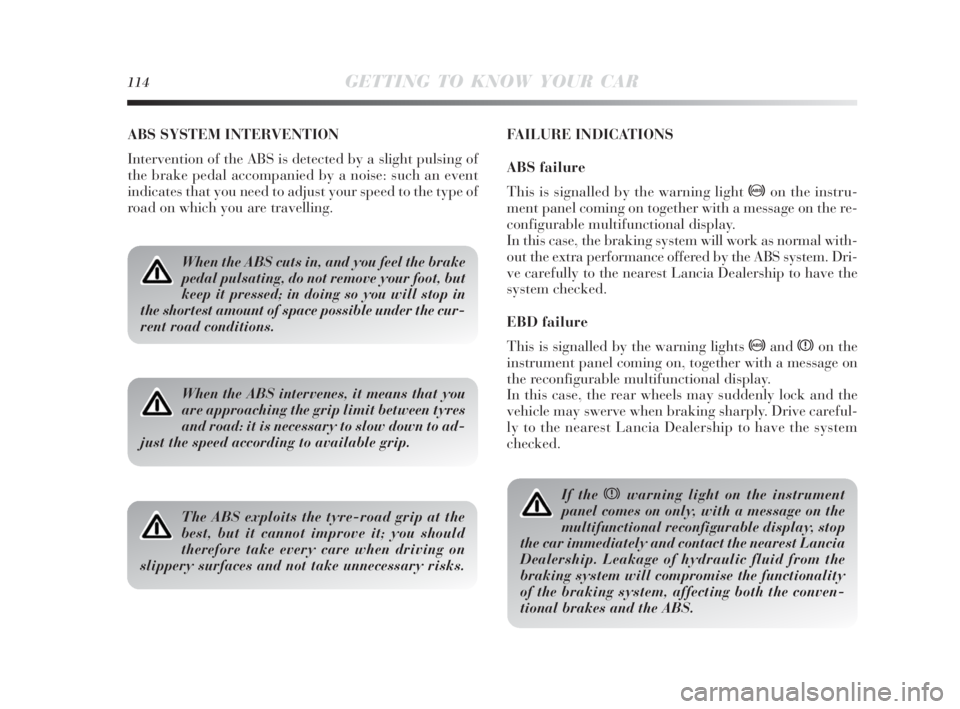
114GETTING TO KNOW YOUR CAR
ABS SYSTEM INTERVENTION
Intervention of the ABS is detected by a slight pulsing of
the brake pedal accompanied by a noise: such an event
indicates that you need to adjust your speed to the type of
road on which you are travelling.FAILURE INDICATIONS
ABS failure
This is signalled by the warning light >on the instru-
ment panel coming on together with a message on the re-
configurable multifunctional display.
In this case, the braking system will work as normal with-
out the extra performance offered by the ABS system. Dri-
ve carefully to the nearest Lancia Dealership to have the
system checked.
EBD failure
This is signalled by the warning lights >andxon the
instrument panel coming on, together with a message on
the reconfigurable multifunctional display.
In this case, the rear wheels may suddenly lock and the
vehicle may swerve when braking sharply. Drive careful-
ly to the nearest Lancia Dealership to have the system
checked.
When the ABS cuts in, and you feel the brake
pedal pulsating, do not remove your foot, but
keep it pressed; in doing so you will stop in
the shortest amount of space possible under the cur-
rent road conditions.
When the ABS intervenes, it means that you
are approaching the grip limit between tyres
and road: it is necessary to slow down to ad-
just the speed according to available grip.
The ABS exploits the tyre-road grip at the
best, but it cannot improve it; you should
therefore take every care when driving on
slippery surfaces and not take unnecessary risks.
If the xwarning light on the instrument
panel comes on only, with a message on the
multifunctional reconfigurable display, stop
the car immediately and contact the nearest Lancia
Dealership. Leakage of hydraulic fluid from the
braking system will compromise the functionality
of the braking system, affecting both the conven-
tional brakes and the ABS.
001-142 Delta 3ed gb 30-11-2009 11:22 Pagina 114
Page 131 of 276
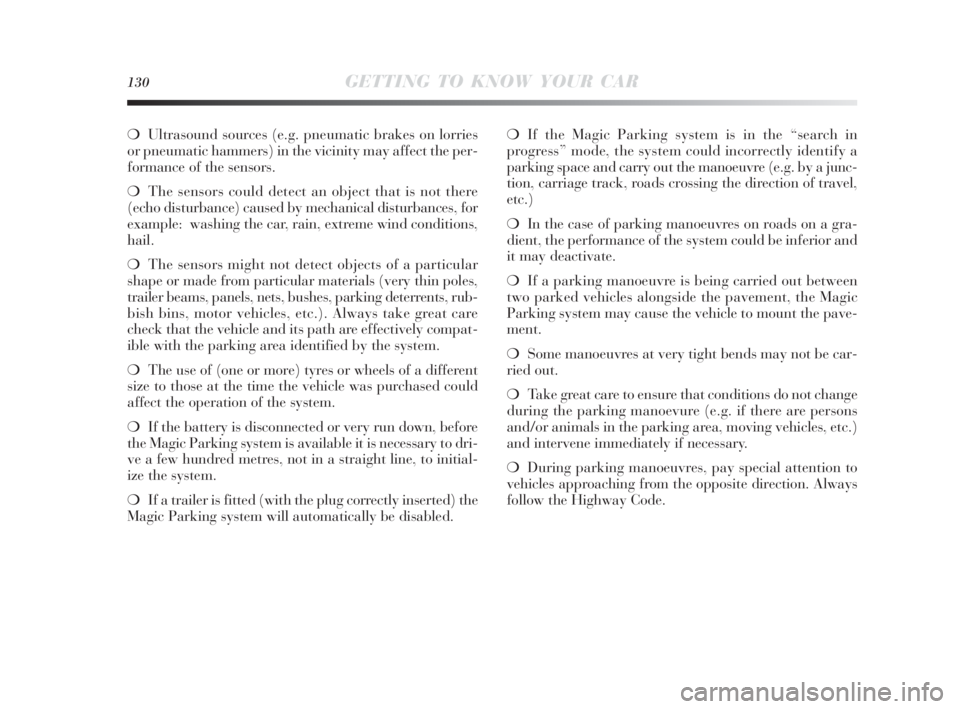
130GETTING TO KNOW YOUR CAR
❍Ultrasound sources (e.g. pneumatic brakes on lorries
or pneumatic hammers) in the vicinity may affect the per-
formance of the sensors.
❍The sensors could detect an object that is not there
(echo disturbance) caused by mechanical disturbances, for
example: washing the car, rain, extreme wind conditions,
hail.
❍The sensors might not detect objects of a particular
shape or made from particular materials (very thin poles,
trailer beams, panels, nets, bushes, parking deterrents, rub-
bish bins, motor vehicles, etc.). Always take great care
check that the vehicle and its path are effectively compat-
ible with the parking area identified by the system.
❍The use of (one or more) tyres or wheels of a different
size to those at the time the vehicle was purchased could
affect the operation of the system.
❍If the battery is disconnected or very run down, before
the Magic Parking system is available it is necessary to dri-
ve a few hundred metres, not in a straight line, to initial-
ize the system.
❍If a trailer is fitted (with the plug correctly inserted) the
Magic Parking system will automatically be disabled.❍If the Magic Parking system is in the “search in
progress” mode, the system could incorrectly identify a
parking space and carry out the manoeuvre (e.g. by a junc-
tion, carriage track, roads crossing the direction of travel,
etc.)
❍In the case of parking manoeuvres on roads on a gra-
dient, the performance of the system could be inferior and
it may deactivate.
❍If a parking manoeuvre is being carried out between
two parked vehicles alongside the pavement, the Magic
Parking system may cause the vehicle to mount the pave-
ment.
❍Some manoeuvres at very tight bends may not be car-
ried out.
❍Take great care to ensure that conditions do not change
during the parking manoevure (e.g. if there are persons
and/or animals in the parking area, moving vehicles, etc.)
and intervene immediately if necessary.
❍During parking manoeuvres, pay special attention to
vehicles approaching from the opposite direction. Always
follow the Highway Code.
001-142 Delta 3ed gb 30-11-2009 11:22 Pagina 130
Page 215 of 276

214IN AN EMERGENCY
TOWING THE CAR
The tow ring provided with the car is housed in the tool
box under the luggage compartment mat.
FASTENING THE TOW RING fig. 43-44
Proceed as follows:
❍release cap A;
❍take the tow hook B from its seat in the tool support;
❍tighten the ring on the rear or front threaded pin.
fig. 43L0E0090mfig. 44L0E0091m
Before starting towing operations, turn the ig-
nition key to MAR and then to STOP, without
extracting it. If the key is extracted, the steer-
ing wheel lock will be automatically activated, thus
preventing steering. The power brakes and the elec-
trical power steering will not work while the car is be-
ing towed. More effort on the brake pedal and steer-
ing wheel will therefore be required. Do not use wires
for towing. Do not jerk. Make sure not to damage parts
in contact with the car while towing. Respect the spe-
cific rules of the Highway Code when towing the car
specifically in relation to the towing device and the be-
haviour to maintain on the road. Do not start the en-
gine while towing the car.
175-214 Delta 4ed gb 24-02-2010 14:36 Pagina 214
Page 218 of 276
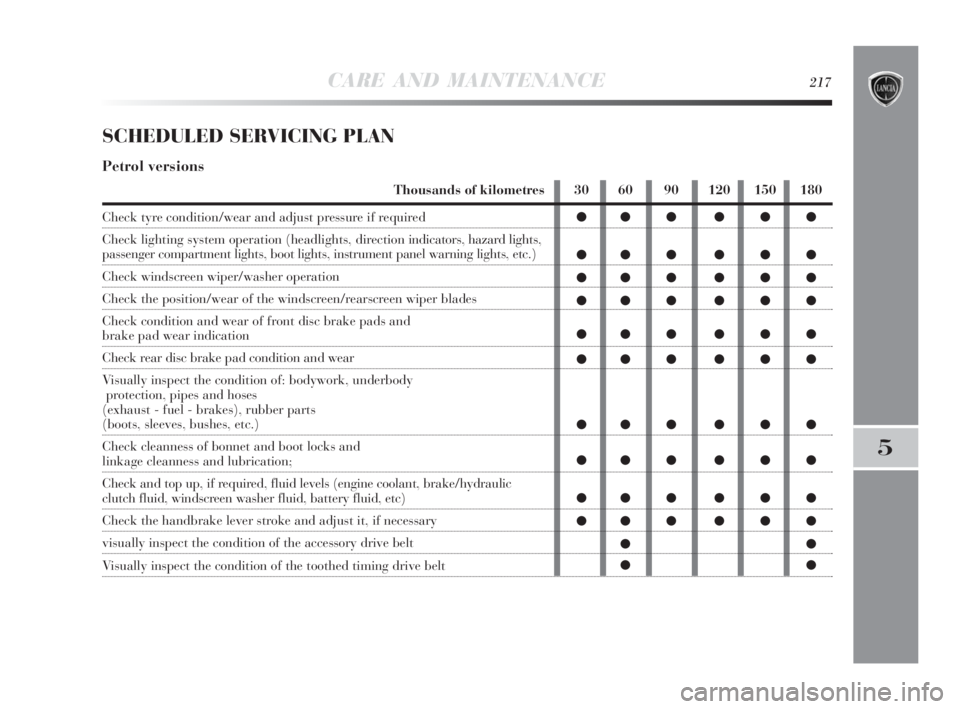
CARE AND MAINTENANCE217
5
SCHEDULED SERVICING PLAN
Petrol versions
Thousands of kilometres
Check tyre condition/wear and adjust pressure if required
Check lighting system operation (headlights, direction indicators, hazard lights,
passenger compartment lights, boot lights, instrument panel warning lights, etc.)
Check windscreen wiper/washer operation
Check the position/wear of the windscreen/rearscreen wiper blades
Check condition and wear of front disc brake pads and
brake pad wear indication
Check rear disc brake pad condition and wear
Visually inspect the condition of: bodywork, underbody
protection, pipes and hoses
(exhaust - fuel - brakes), rubber parts
(boots, sleeves, bushes, etc.)
Check cleanness of bonnet and boot locks and
linkage cleanness and lubrication;
Check and top up, if required, fluid levels (engine coolant, brake/hydraulic
clutch fluid, windscreen washer fluid, battery fluid, etc)
Check the handbrake lever stroke and adjust it, if necessary
visually inspect the condition of the accessory drive belt
Visually inspect the condition of the toothed timing drive belt30 60 90 120 150 180
●●● ●●●
●●● ●●●
●●● ●●●
●●● ●●●
●●● ●●●
●●● ●●●
●●● ●●●
●●● ●●●
●●● ●●●
●●● ●●●
●●
●●
215-242 Delta 3ed gb 11-11-2009 12:14 Pagina 217
Page 220 of 276
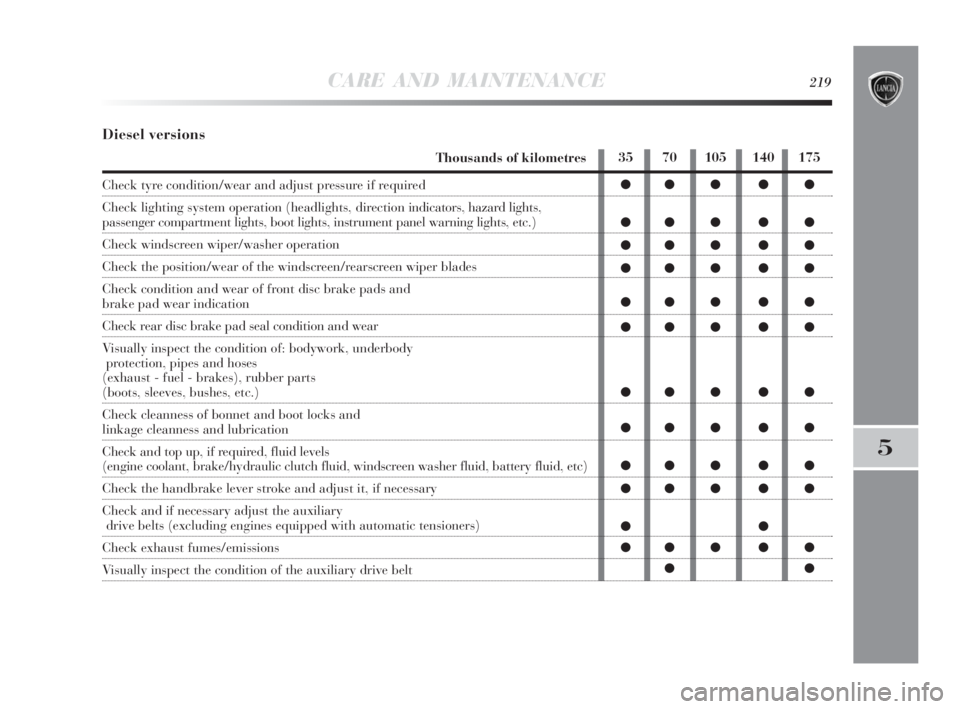
CARE AND MAINTENANCE219
5
Diesel versions
Thousands of kilometres
Check tyre condition/wear and adjust pressure if required
Check lighting system operation (headlights, direction indicators, hazard lights,
passenger compartment lights, boot lights, instrument panel warning lights, etc.)
Check windscreen wiper/washer operation
Check the position/wear of the windscreen/rearscreen wiper blades
Check condition and wear of front disc brake pads and
brake pad wear indication
Check rear disc brake pad seal condition and wear
Visually inspect the condition of: bodywork, underbody
protection, pipes and hoses
(exhaust - fuel - brakes), rubber parts
(boots, sleeves, bushes, etc.)
Check cleanness of bonnet and boot locks and
linkage cleanness and lubrication
Check and top up, if required, fluid levels
(engine coolant, brake/hydraulic clutch fluid, windscreen washer fluid, battery fluid, etc)
Check the handbrake lever stroke and adjust it, if necessary
Check and if necessary adjust the auxiliary
drive belts (excluding engines equipped with automatic tensioners)
Check exhaust fumes/emissions
Visually inspect the condition of the auxiliary drive belt35 70 105 140 175
●● ● ● ●
●● ● ● ●
●● ● ● ●
●● ● ● ●
●● ● ● ●
●● ● ● ●
●● ● ● ●
●● ● ● ●
●● ● ● ●
●● ● ● ●
●●
●● ● ● ●
●●
215-242 Delta 3ed gb 11-11-2009 12:14 Pagina 219
Page 223 of 276
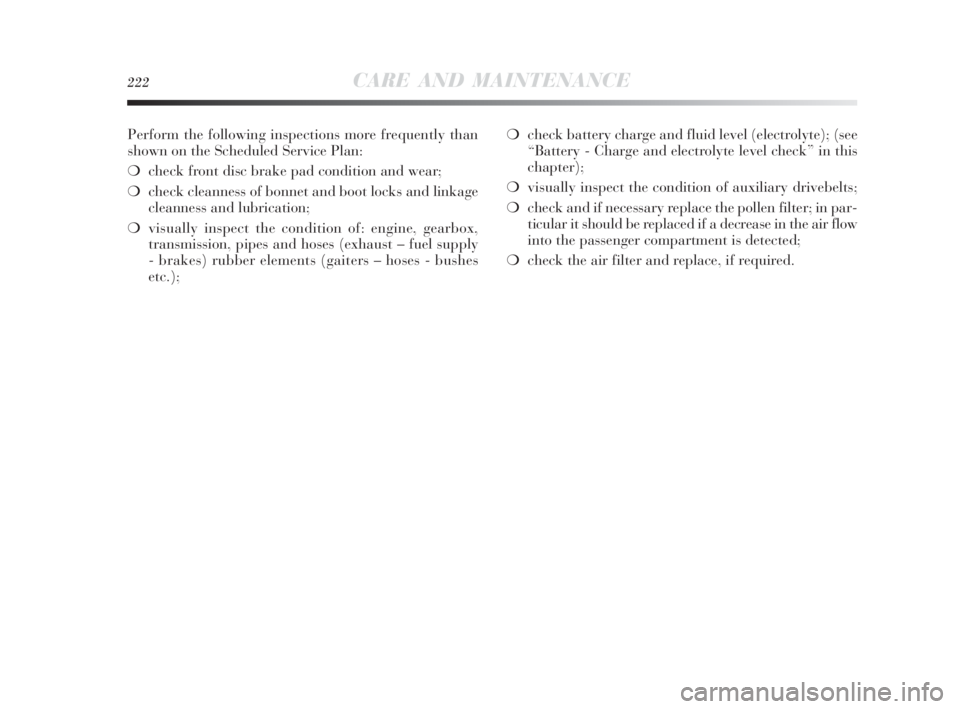
222CARE AND MAINTENANCE
Perform the following inspections more frequently than
shown on the Scheduled Service Plan:
❍check front disc brake pad condition and wear;
❍check cleanness of bonnet and boot locks and linkage
cleanness and lubrication;
❍visually inspect the condition of: engine, gearbox,
transmission, pipes and hoses (exhaust – fuel supply
- brakes) rubber elements (gaiters – hoses - bushes
etc.);❍check battery charge and fluid level (electrolyte); (see
“Battery - Charge and electrolyte level check” in this
chapter);
❍visually inspect the condition of auxiliary drivebelts;
❍check and if necessary replace the pollen filter; in par-
ticular it should be replaced if a decrease in the air flow
into the passenger compartment is detected;
❍check the air filter and replace, if required.
215-242 Delta 3ed gb 11-11-2009 12:14 Pagina 222
Page 244 of 276
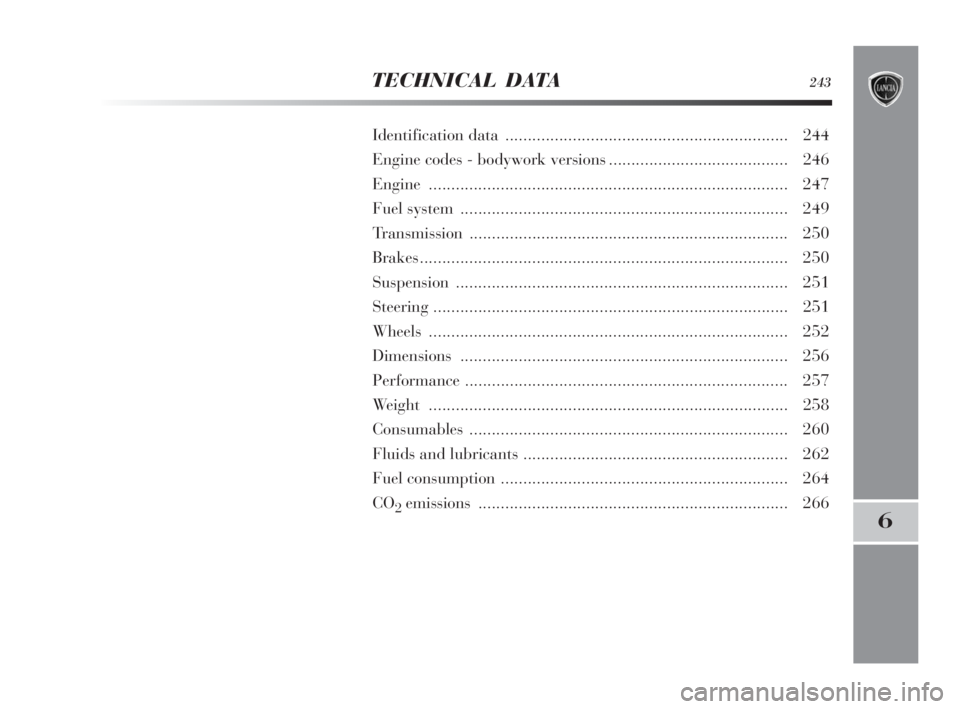
TECHNICAL DATA243
6
Identification data ............................................................... 244
Engine codes - bodywork versions........................................ 246
Engine ................................................................................ 247
Fuel system ......................................................................... 249
Transmission ....................................................................... 250
Brakes.................................................................................. 250
Suspension.......................................................................... 251
Steering ............................................................................... 251
Wheels ................................................................................ 252
Dimensions......................................................................... 256
Performance ........................................................................ 257
Weight ................................................................................ 258
Consumables ....................................................................... 260
Fluids and lubricants........................................................... 262
Fuel consumption................................................................ 264
CO
2emissions..................................................................... 266
243-266 Delta 3ed gb 11-11-2009 12:16 Pagina 243
Page 251 of 276

Six forward gears plus reverse with synchronisers for forward gears
Self-adjusting with pedal without idle stroke
Front
250TECHNICAL DATA
TRANSMISSION
Self ventilating discs
Disc
Controlled by hand lever, acting on rear brakes
BRAKES
IMPORTANT Water, ice and salt sprinkled on the roads may deposit on the brake discs reducing braking efficiency
the first time the brakes are applied.
1.4 Turbo Jet - 1.6 Multijet - 1.9 Twin Turbo Multijet - 2.0 Multijet
Gearbox
Clutch
Drive
1.4 Turbo Jet - 1.6 Multijet - 1.9 Twin Turbo Multijet - 2.0 Multijet
Service brakes:
– front
– rear
Parking brake
243-266 Delta 3ed gb 11-11-2009 12:16 Pagina 250
Page 259 of 276
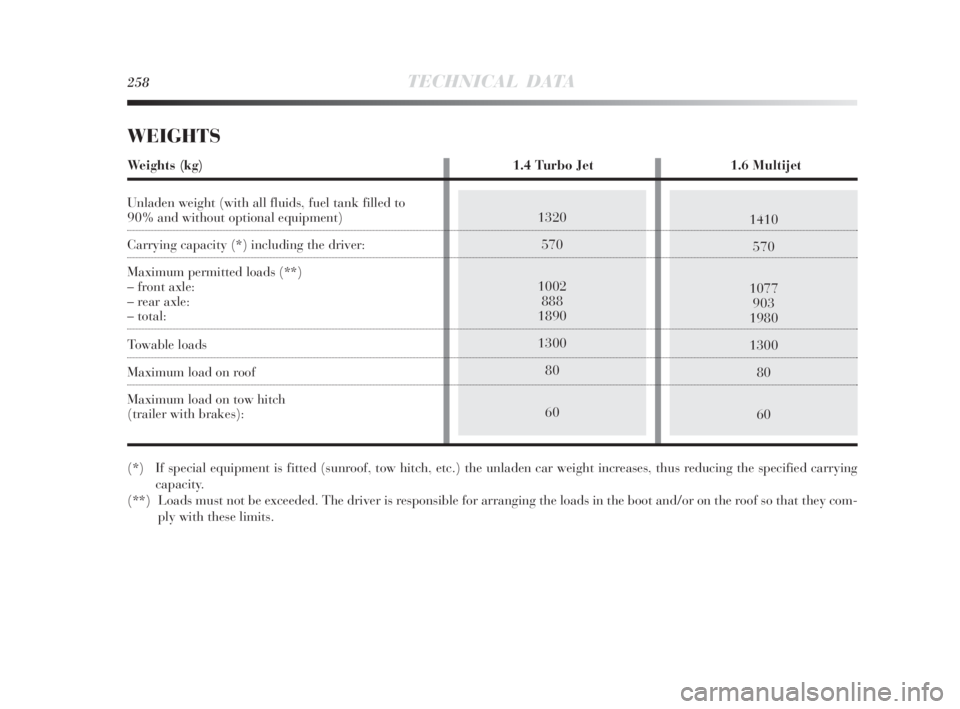
1410
570
1077
903
1980
1300
80
601320
570
1002
888
1890
1300
80
60
258TECHNICAL DATA
WEIGHTS
Weights (kg) 1.4 Turbo Jet 1.6 Multijet
Unladen weight (with all fluids, fuel tank filled to
90% and without optional equipment)
Carrying capacity (*) including the driver:
Maximum permitted loads (**)
– front axle:
– rear axle:
– total:
Towable loads
Maximum load on roof
Maximum load on tow hitch
(trailer with brakes):
(*) If special equipment is fitted (sunroof, tow hitch, etc.) the unladen car weight increases, thus reducing the specified carrying
capacity.
(**) Loads must not be exceeded. The driver is responsible for arranging the loads in the boot and/or on the roof so that they com-
ply with these limits.
243-266 Delta 3ed gb 11-11-2009 12:16 Pagina 258